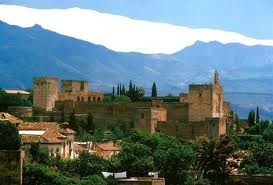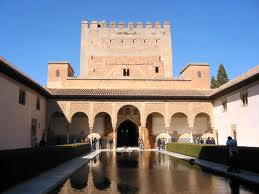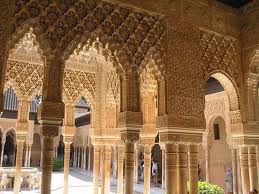Granada Alhambra

Where: Calle Real de la Alhambra, S/N, 18009
Opening hours:
From October 15 to March 14, Monday to Sunday from 8.30 am to 6 pm. Night visits on Friday and Saturday from 8 pm to 9.30 pm.
From March 15 to October 14: Monday to Sunday from 8.30 to 8 pm. Night visit from Tuesday to Saturday from 8 pm to 22.30 pm.
A large part of Spain was occupied by Muslims between the 8th and 15th century. Al-Andalus is the name of the territory they occupied. The Moorish empire was a powerful one, one that brought technology and unexpected advancement. Not only that, religions could peaceful co-exist, this is why in many parts of the Iberian Peninsula, including Andalucía (where their presence is stronger than anywhere) Jews, Christians and Arabs shared cities and towns without major conflicts.
Alhambra was the palatine city located in Granada. It is a great palatial complex and fortress (also know as alcázar). It housed the ruler and the court of the Nasrid kingdom of Granada. Its name means 'the red one', referring to the red fortress and it receives more than 2 million visitors a year. It counts among the chief activities recommended by Spain travel guides.
The greatest beauty doesn't lie in the interior of Alhambra , whose decoration is among the highest of Andalucían art but rather it was located and adapted to the environment, thus generating a a landscape completely integrated with nature. Since 2007, Alhambra is one of Spain's 12 treasures.
A bit of the Alhambra's history

In 1283 Al-Ahmar, founder of the Nasrid dynasty settled in the old fortress located in Granada, Alcabaza de Albaicín. The ruins on the hill of Alhambra caught his attention. He then decided to reconstruct it and establish a branch of the court there. That is how the construction of the building as we know it today came about. The Alhambra was a palace, a citadel, the residence of Nasrid sultans, senior officials, court servants and elite soldiers. It reached its peak in the second half of the 14th century, during the rule of sultan Yusuf I (1333-1354) and the second reign of Muhammad V (1362-1391).
Granada was the capital of the Nasrid kingdom, and it progressively received more Muslim population as the Christian reconquista spread. The city grew and adjusted, new neighbourhoods appeared pretty much until it was conquered in the 15th century. In 1492, the Alhambra was conquered by the Catholic Monarchs and the last sultan, Boabdil was said to cry when he looked at his city for one last time, while his mother scolded him: 'you cry like a woman for what you could not defend like a man'. However this is a widespread legend that has not been proved or documented.
After falling back into Christian hands, the Alhambra was established as a Royal residence under the jurisdiction of the count of Tendilla. The Catholic Monarchs commissioned huge restorations, hiring Moorish craftsmen. The Alhambra was generally admired by humanists and artists alike, and for many centuries it would keep its splendor. However Philip V (1700-1746) dispossessed the heir of Tendilla, sending the Alhambra on a period of total disregard that lasted up to 40 years.
Another dark episode in the life of the Alhambra was the Napoleonic occupation, when a French soldier attempted to blast it in 1812, as they withdrew. Only the daring of a Spanish soldier saved it from complete destruction.
After the revolution of 1868, the Alhambra was taken from the crown and passed to the dominion of the state. It was declared as a 'National Monument' two years later. In 1984 the Alhambra was declared a World Heritage by the UNESCO. Be sure to put it down in your to-do list of activities when you visit Granada.
Visiting the Alhambra

The Palatine city: housed six palaces and two palace towers. Now only the Palace of Comares and Palace of the Lions remain. It is the only Islamic palatine city in Spain that has been preserved, thanks to the continuous use it has been given through time.
Monument Environment: you have the chance to access a series of complementary spaces especially marked to be toured in trek routes. Among them, Dalarusa, also known as The Palace of the Bride, located in the highest part of Cerro del Sol; Silla del Moro (The Moor's Seat) also known as Saint Helena Castle; and the Alhambra woods.
It is advisable to get your tickets some time in advance. If you decide to spend more time in the city, you can get the Red Circle Pass and get to see this impressive monument more slowly and thoroughly.



